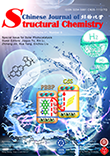
Ruiqi Gao, Huan He, Junxian Bai, Lei
Hao,
Rongchen Shen*, Peng Zhang, Youji Li and Xin Li*
The blue cover, together with elements such as blisters, lightning and the sun, highlights the good prospect of this new type of heterojunction as a photocatalytic material. The "S" shaped dragon depicted by the element of water rises from the bottom, implying that the dragon gets water and magically turns water into green hydrogen over organic/inorganic S-type heterojunction photocatalyst under sunlight irradiation.
Asymmetric Structure Awakened n-π* Electron Transition in Sulfur and Selenium Co-doped g-C3N4 with Efficient Photocatalytic Performance
Tian Liu, Yunfeng Li*, Hejia Sun, Min Zhang, Zhiling Xia and Qing Yang
Chin. J. Struct. Chem. 2022, 41, 2206055-2206061 DOI: 10.14102/j.cnki.0254-5861.2022-0152
June 20, 2022
photocatalysis, Co-doping, n-π* transition, charges transfer, photo-degradation
ABSTRACT
Sulfur and selenium
co-doped graphitic carbon nitride (SSCN) with efficient
photocatalytic activity was synthesized by synchronously introducing sulfur and
selenium atoms into the melon structure of g-C3N4 (GCN)
via a facile solid-phase thermal reaction of GCN and SeS2. The
as-prepared SSCN possesses a larger specific surface area with a richer pore
structure that provides more active centers for catalytic reaction. More
importantly, the asymmetric structure of SSCN due to introducing sulfur and
selenium not only maintains an easier activation of π-π* electron
transition but also awakens the n-π* electron transition in g-C3N4.
Moreover, the n-π* electron transition of SSCN can be controlled through
changing the amount of SeS2, which can greatly extend the
photo-response range to 600 nm. As a result, the SSCN
samples show an excellent photo-degradation
performance for typical antibiotic of tetracycline
hydrochloride (TC). The specific degradation route and main intermediates of TC
based on liquid chromatograph mass spectrometer (LC-MS) analysis are also
investigated and discussed.






